CBSE Previous Year Question Papers Class 12 Economics 2016 Outside Delhi
Time allowed : 3 hours
Maximum marks: 70
In
case
Section – A
Question 1.
What is the relation between Average Variable Cost and Average Total Cost, If Total Fixed Cost is zero? [1]
Answer:
‘Average variable cost is a part of average total cost because average variable cost and average fixed cost together make average total cost but when total fixed cost is zero, then :
A VC = ATC
Question 2.
A firm is able to sell any quantity of a good at a given price. The firm’s marginal revenue will be: [1]
(Choose the correct alternative)
(a) Greater than Average Revenue
(b) Less than Average Revenue
(c) Equal to Average Revenue
(d) Zero
Answer:
(c) Equal to Average Revenue
Question 3.
When does ‘Change in demand’ take place? [1]
Answer:
Change in demand takes place when there are changes in factors other than price.
Question 4.
Differentiated products is a characteristic of : [1]
(choose correct answer)
(a) Monopolistic competition only
(b) Oligopoly only
(c) Both monopolistic competition and oligopoly
(d) Monopoly
Answer:
(c) Both monopolistic competition and oligopoly.
Question 5.
Demand curve of a firm is perfectly elastic under: [1]
(Choose the correct alternative)
(a) Perfect competition
(b) Monopoly
(c) Monopolistic Competition
(d) Oligopoly
Answer:
(a) Perfect competition.
Question 6.
A consumer consumes only two goods X and Y. Marginal utilities of X and Y are 3 and 4 respectively. Prices of X and Y are ₹ 4 per unit each. Is consumer in equilibrium? What will be further reaction of the consumer ? Give reasons. [3]
Answer:
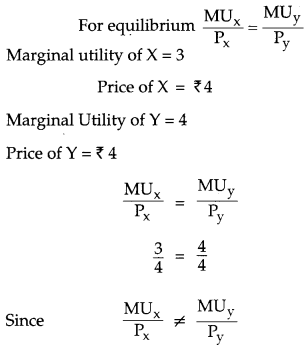
Hence, Consumer is not in equilibrium
To reach equilibrium level, consumer should decrease the consumption of good X.
Question 7.
What will be the effect of 10 percent rise in price of a good on its demand if price elasticity of demand is (a) Zero, (b) -1, (c) -2. [3]
Answer:
Percentage change in price = 10%
(a) E
d
= 0 .
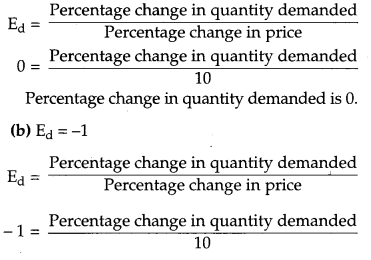
Percentage change in quantity demanded is -10%
(c) E
d
= -2

Percentage change in quantity demanded is -20%
Question 8.
What is minimum price ceiling ? Explain its implications.
OR
If the prevailing market price is above the equilibrium price, explain its chain of effects. [3]
Answer:
Minimum price ceiling is also known as price floor, which is the minimum allowable price set above the equilibrium price by the government.
The need for minimum price ceiling arises when government finds that equilibrium price is too low for the producers. This policy is in the interest of producers. It leads to surplus and illegal selling below the equilibrium price.
For effective minimum support price or price floor, it must be accompanied by government purchases either to increase its buffer stocks or exports.
Implications of Minimum Price Ceiling :
(a) Minimum price ceiling ensures the farmers that they will get the minimum price for their production which helps them to produce more in order to earn their bread and butter with the help of government. It also states that their whole produce will be sold in the market.
(b) With the minimum price given by the government to the farmers, increases the income of the poor people.
OR
When the prevailing price is above the equilibrium price , then there is condition of excess supply. Excess supply induces seller to sell more and in order to sell more, seller has to reduce the price of their output. The fall in price will continue till the price reaches the equilibrium price where market demand and market supply equals and the equilibrium price is fixed.
As can be seen in the above graph that at price OP
2
, the quantity supplied is OQ
3
while the quantity demanded is OQ
2
so there is the excess supply of Q
2
Q
3
is the market. Hence, this leads to the seller to sell their output at lower prices. With the fall in price the quantity demanded of the commodity increases. The price continues to fall till is reaches OP
1
. At OP
1
price the quantity demanded becomes equal to quantity supplied OQ
1
and the equilibrium establishes at Point E.
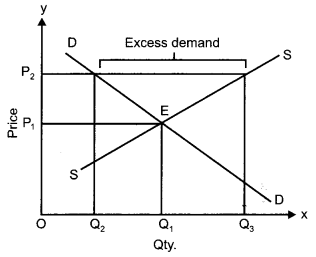
Question 9.
Define demand. Name the factors affecting market demand. [4]
Answer:
Demand: Demand for a commodity refers to the quantity of a commodity which a consumer is willing to buy at a given price and in a given period of time.
Factors affecting Market demand :
(1) Population: Increase in the population increases the demand. Composition of the population also affects the demand. Composition of the population means the distribution of the population on the basis of sex, age etc. A change in the composition of the population has an effect on the demand of the commodity.
of
capitalistic
economy
the
Question 10.
Define fixed cost. Give an example. Explain with reason the behaviour of Average Fixed cost as output is increased.
OR
Define marginal product. State the behaviour of marginal product when only one input is increased and other inputs are held constant. [4]
Answer:
Fixed cost is the cost which does not change with the change in the level of output. This is incurred on fixed factors like machines, building etc. Fixed cost does not change with the change in the level of output. For eg. a sugar mill usually remains closed for about 3 months in a year for want of raw material but still the mill owner has to incur certain costs like rent of the building, interest on past borrowings, salaries of permanent employees, taxes, etc.
On the other hand AFC is fixed cost per unit of output
AFC = TFC/Output produced
For eg.
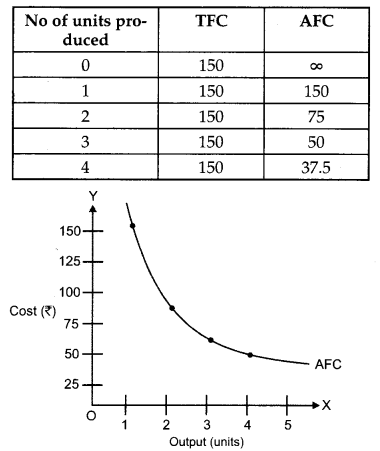
The shape of AFC curve is downward sloping curve from left to right because average fixed cost goes on falling with every increase in the output as TFC remains constant. AFC curve neither touches X-axis because AFC always remain positive nor touches Y-axis because AFC approaches infinity when production is zero.
OR
Marginal product is an addition to the total product when an additional unit of only variable factor is used, keeping other things same. Marginal product measures extra output per extra unit of input holding all other inputs fixed

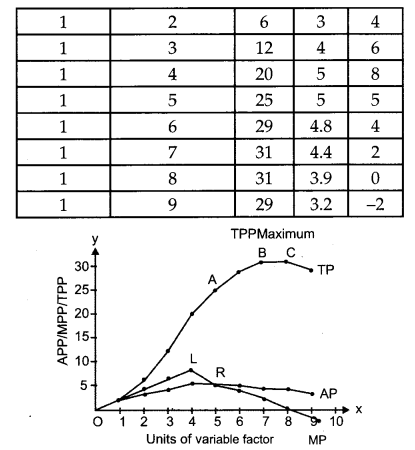
TP increases continuously from point O to B. It increases at an increasing rate from O to A and at diminishing rate from A to B. TP is maximum at point B and remains up to point C.
MP (MPP) curve initially rises, reaches its maximum and ultimately declines taking the shape of inverted -U .
AP (APP) curve first rises, reaches its maximum and then declines taking the shape of an inverted -U.
Question 11.
When price of a commodity falls from ₹ 12 per unit to ₹ 9 per unit, the producer supplies 75 percent less output. Calculate price elasticity of supply. [4]
Answer:
Percentage change in quantity supplied = – 75%
Old price = ₹ 12
New price = ₹ 9
Change in price = 9 – 12 = -3
Percentage change in price = (- 3 ÷ 12) × 100
= -25%
E
s
= Percentage change in quantity supplied Percentage change in price = – 75 % ÷ – 25%
= \(\frac{-75}{-25}\) = 3
Question 12.
Why do central problems of an economy arise? Explain the central problem of “for whom to produce.” [6]
Answer:
The problem of making choices among alternative uses of resources is called central problems of the economy. Scarcity of resources
having alternative uses in relation to unlimited wants has given rise to central problems.
Main causes of central problems are :
(1) Unlimited wants.
(2) Limited resources.
(3) Alternative uses of resources.
For whom to produce: This is the third problem of allocation of resources. It is related to distribution of income. This problem refers to the decision regarding the share of different factors of production in the national product of the country. Goods and services are produced for the people who can purchase them, and purchasing power depends upon their income. We know that the output in an economy is the result of the combined efforts of various factors of production.
decision
Question 13.
Explain three properties of indifference curves. [6]
Answer:
An indifference curve is a curve which shows all the combinations of two goods that give equal satisfaction to the consumer. Indifference curve shows consumers behaviour is indifferent towards various combination of two goods because they give same level of satisfaction.
Properties of indifference curve :
(1) Indifference curve slopes down to the right. It implies that consumer is willing to give up some units of one commodity to get more units of another commodity so as to stay at the same level of satisfaction.
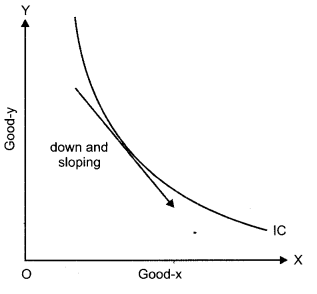
(2) Higher Indifference curves represent higher level of satisfaction and indifference curve cannot meet or intersect. Two indifference curves never intersects. In the figure, point A and B lies on the f same indifference curve IC
1
giving same level of satisfaction while point A and C also lie on the same indifference curves IC
1
giving same level of satisfaction. This implies that combination B and C should also give same level of satisfaction, but this is not possible because combinations C lies on the higher indifference curve than B.
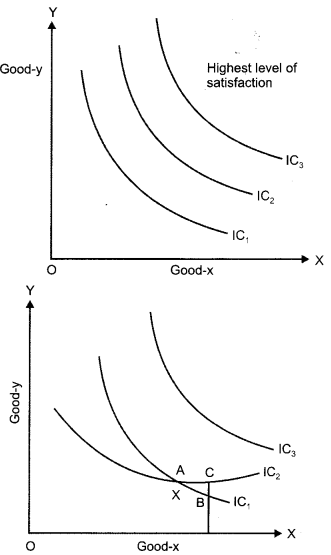
(3) Indifference curves are always convex to the origin O because of diminishing MRS. It implies that marginal rate of substitution diminishes along an indifference curve. This implies that as consumer gets more and more of one good, he is willing to give up less and less of another.
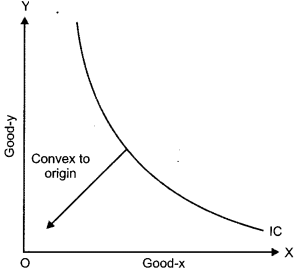
Question 14.
Examine the effect of (a) fall in the own price of good X and (b) rise in tax rate on good X, on the supply curve. Use diagrams. [6]
Answer:
(a) Fall in the own price of good X-It leads to contraction in supply. When the quantity supplied of the commodity falls with fall in the price and other things remaining same is called contraction in supply. It is the movement along the supply curve. Contraction is shown as the downward movement along the supply curve. For example movement from point 1 to point 2 on the SS supply curve is downward movement along the supply curve.
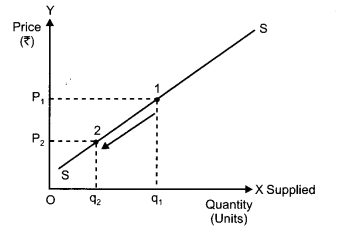
(b) Rise in tax rate on good X on the supply curve- It leads to decrease in supply. Supply of the commodity falls due to factors other than price. The leftward shift in the supply curve indicates decrease in the supply. In case of decrease in supply, supply curve shifts to the left from S
1
S
1
to S
2
S
2
.
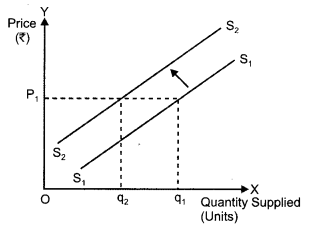
Question 15.
Explain the implications of the following in a perfectly competitive market: [6]
(a) Large number of sellers
(b) Homogeneous products.
OR
(a) Barriers to entry of new firms
(b) A few or a few big sellers
Answer:
Implications in a perfectly competitive market:
(a) Large number of sellers : The number of sellers is so large that individually they can’t influence the existing price in the market. Large number of sellers in the market implies that the share of each seller in total market supply is so small that no single seller can influence the price and each firm is the price taker.
(b) Homogeneous product : Products sold in the perfectly competitive market is that they are identical in all respects like quality, colour, size and all are the perfect substitutes of each other. Homogeneous products implies that all the firms have to charge the same price for the product i.e uniform prices prevail in the market.
OR
Implications in an oligopoly market :
(a) Barriers to entry of new firms: There is very tough competition among the firms, so it is very difficult for the new firm to enter into the oligopoly market.
is
Section – B
Question 16.
Define flows. [1]
Answer:
A flow is a variables whose magnitude which is measured over a period of time. e.g. National Income.
Question 17.
National income is the sum of factor incomes accuring to: [1]
(Choose the correct alternative)
(a) Nationals
(b) Economic territory
(c) Residents
(d) Both residents and non-residents
Answer:
(c) Residents.
Question 18.
What are revenue receipts in a government budget? [1]
Answer:
Revenue Receipts are the government receipts which neither create liabilities nor reduce assets. Tax revenue and non-tax revenue are the revenue receipts in the government ‘ budget.
Question 19.
Primary deficit equals : [1]
(Choose the correct alternative)
(a) Borrowings
(b) Interest payments
(c) Borrowings less interest payments
(d) Borrowings and interest payments both
Answer:
(c) Borrowings less interest payments.
Question 20.
Foreign exchange transactions which are independent of other transactions in the Balance of Payments Account are called : [1]
(Choose the correct alternative)
(a) Current transactions
(b) Capital transactions
(c) Autonomous transactions
(d) Accomodating transactions
Answer:
(c) Autonomous transactions.
Question 21.
Assuming real income to be ₹ 200 crore and price index to be 135, calculate nominal income. [3]
Answer:
Real income = ₹ 200 crores
Price index = 135
Let the base year’s price index be 100
Nominal Income = ?
Real income = (Nominal income ÷ Price index of current year) × Price index of base year.
X Price Index of base year = (Nominal income ÷ 135) × 100
Nominal Income = (200 × 135) ÷ 100
= 27000 ÷ 100
= ₹ 270 crores.
Question 22.
What is aggregate demand? State its components.
OR
Explain how controlling money supply is helpful in reducing excess demand. [3]
Answer:
Aggregate demand is the total demand for final goods and services in the economy. It also refers to the total amount of money which all sectors are ready to spend on purchase of goods and services. Aggregate demand is the total expenditure on consumption and investment.
Components of AD are :
(a) Household (or private) consumption demand (C): Value of goods and services that households are able and willing to buy.
taken
on
(d) Net exports (exports-imports) demand (X – M): Net exports is the difference between exports of goods and services and imports of goods and services during a given period. Net exports show the demand of foreign countries for our goods and services over our demand for foreign countries goods and services. This strengthens the income, output and employment process of our economy.
AD = C + I + G + (X – M)
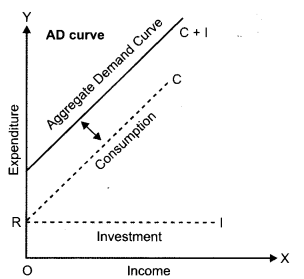
When the planned aggregate expenditure is greater than the available output at full employment level, this situation is termed as excess demand. It leads to an inflationary gap in the economy. It arises because of increase in money supply due to deficit financing leading to increase in consumption demand or an increase in autonomous investment without the corresponding increase in savings. So, there is a need to reduce the money supply in the economy in order to curb the demand levels in an economy. As the purchasing power will reduce, aggregate demand levels will come down. This can be done both by using monetary and fiscal policy.
Question 23.
An economy is in equilibrium. Calculate Marginal Propensity to consume : [3]
National income = 1000
Autonomous consumption expenditure = 200
Investment expenditure = 100
Answer:
National income = 1000
Autonomous consumption expenditure = 200
Investment expenditure = 100
National Income = Consumption + Investment Expenditure
Y = C + cY +1
1000 = 200 +c(1000) + 100
1000 = 300 +c(1000)
1000-300 = c(1000)
700 = c(1000)
c = 700 / 1000
c = 0.7
Marginal propensity to consume = 0.7.
Question 24.
Sale of petrol and diesal cars is rising particularly in big cities. Analyse its impact on gross domestic product and welfare. [4]
Answer:
Impact of rising sale of petrol and diesel cars pm gross domestic product- GDP will increase because there is increasing demand of petrol and diesel cars in the big cities and to fulfil this increasing demand , the companies have to produce more and have to increase their level of production which will lead to increase in GDP.
the
Question 25.
Explain the ‘medium of exchange’ function of money. How has it solved the related problem created by barter?**
OR
Explain the ‘standard of deferred payment’ function of money. How has it solved the related problem created by barter ? ** [4]
Question 26.
Explain how ‘Repo Rate’ can be helpful in controlling credit creation. [4]
Answer:
The rate at which the central bank (RBI) lends money to commercial banks is called repo rate . It is an instrument of monetary policy. Whenever banks have shortage of funds, they can borrow from RBI. When the repo rate falls, it helps the banks get money at a cheaper rate and vice versa.
When the repo rate is increased, banks are compelled to pay higher interest to RBI which prompts them to raise the interest rates on the loans that they offer to their consumers. It becomes costlier for the consumers to take loans, which leads to shortage of money in the economy and less liquidity. This way repo rate helps in controlling the credit creation.
Thus, a rise in repo rate restricts the flow of money and credit in an economy.
Question 27.
What is the difference between revenue expenditure and capital expenditure? Explain how taxes and government expenditure can be used to influence distribution of income in the society. [6]
OR
What is the difference between direct tax and indirect tax? Explain the role of government budget in influencing allocation of resources.
Answer:
Difference between Revenue expenditure and capital expenditure :
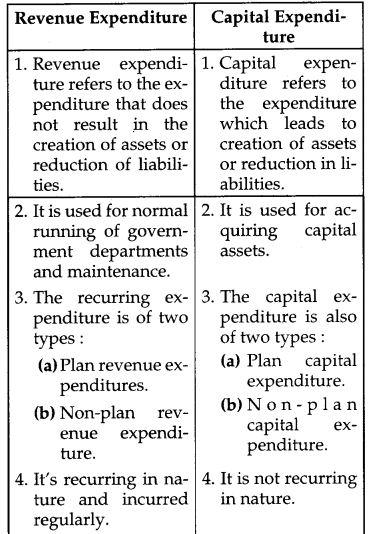
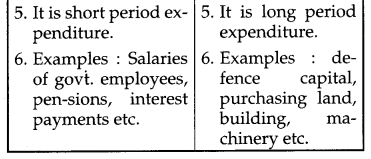
To reduce inequalities of income and wealth, government can influence distribution of income by levying taxes on the rich people and granting subsidies to the poor people. Government levies like taxation, subsidies and public expenditure can be made use of to influence distribution of income in the society.
OR
Difference between Direct tax and Indirect tax
| Direct Tax | Indirect Tax |
| When the liability to pay tax and the burden of that tax falls on the same person, it is called direct tax or we can say when impact & incidence of tax is on same person. | When the liability to pay tax is on one person and the burden of that tax falls on some other person, the tax is called an indirect tax. Hence impact and incidence is on different persons. |
| A direct tax is the tax whose burden is borne by the person on whom it is imposed. | Indirect tax is a tax whose burden can be shifted to others |
| It is progressive in nature | It is regressive in nature. |
| Eg: Income tax, wealth tax | Eg: Excise duty, custom duty. |
Role of government budget in influencing allocation of resources:
To achieve the social and economic objectives, government provides more resources into socially productive sectors like rural electrification, education, health , etc . Moreover, government allocates more funds in the production of socially useful products and draws resources from some other areas to promote balanced economic growth of regions.
Question 28.
Given saving curve, derive consumption curve and state the steps in doing so. Use diagram. [6]
Answer:
Steps of Deriving the consumption curve from saving curve :
(i) Draw 45° line from the origin.
(ii) Take OC equal to OS on Y axis
(iii) Draw perpendicular line form B to R on OX- axis which intersect 45° line at point B.
(iv) Join C and B and extend it to get consumption curve CC.
In the given figure, a straight line saving curve is plotted showing saving function at different levels of income . It shows negative saving at zero level of income and zero saving level at OR level of income. At point R, consumption expenditure = income, whereas to the left of R, consumption expenditure is less than income.
basis
B is the point on consumption curve at which total consumption expenditure ‘(C) is equal to income (Y), At point B, APC (C / Y) =
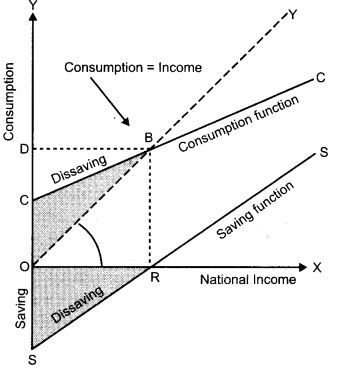
Question 29.
Indian investors lend abroad. Answer the following questions: [6]
(a) In which sub-account and on which side of the Balance of Payments Account such lending is recorded ? Give reasons.
(b) Explain the impact of this lending on market exchange rate.
Answer:
(a) Sub-account – Capital Account. Balance of payment account – Debit Side. Lending to abroad by Indian investor will be recorded in the capital account on the debit side of balance of payment account. It is recorded on the debit side because it is the negative item in the capital account of balance of payment as it shows outflow of foreign currency from our country.
(b) The lending will reduce the supply of foreign currency, because lending is the outflow of foreign currency from our country. This reduction in the supply increases the demand of foreign exchange and the supply of foreign exchange remains Inchanged. This will shift the supply curve from SS to S’S’. The new equilibrium is at point E’ where the exchange rate rises from OR to OR
1
. Leading to abroad by Indian investor affects the supply of foreign currency. This is because lending implies the flow of foreign currency from india to abroad leading to a fall in the supply of foreign currency in the country.
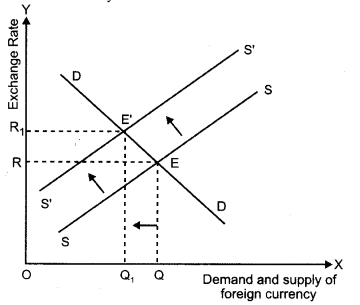
Question 30.
Find Gross National Product at Market Price and (Private Income**): [6]
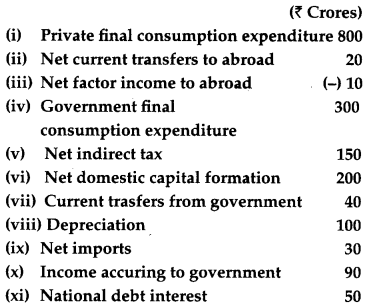
Answer:
GDPmp = Private Final Consumption Expenditure + Government Final Consumption Expenditure + (net domestic capital formation+ depreciation) -net imports
GDPmp = 800 + 300 + (200 + 100) – 30
= 1100 + (300) – 30
= 1400 – 30
= ₹ 1370 crores.
GNPmp = GDPmp – net factor income to abroad
= 1370 – (- 10)
= ₹ 1380 crores.
of
the
Section – A
Question 4.
When does “Change in quantity demanded” take place? [1]
Answer:
Change in quantity demanded takes place when price of the goods changes, other things being same (unchanged).
Question 5.
What happens to the difference between Average Total Cost and Average Variable Cost as production is increased? [1]
Answer:
The difference between Average Total Cost (ATC) and Average Variable Cost (AVC) diminishes as production is increased.
Question 7.
A consumer consumes only two goods X and Y. Marginal utilities of X and Y are 4 and 3 respectively. Price of X and price of Y is ₹ 3 per unit. Is consumer in equilibrium? What will be further reaction of the consumer ? Give reasons. [3]
Answer:
Marginal utility of X = 4
Price of X = ₹ 3
Marginal Utility of Y = 3
Price of Y = ₹ 3
MUx + Px = 4 ÷ 3 = 1.33
MUy+ Py = 3 ÷ 3 = 1
No, the consumer is not in equilibrium and to reach the equilibrium level, the consumer should increase the consumption of good X.
Question 9.
When price of a good rises from ₹ 10 to ₹ 12 per unit, the producer supplies 10 percent more. Calculate price elasticity of supply. [4]
Answer:
Percentage Change in quantity supplied = 10%
Original price (P) = ₹ 10/ unit
New Price (PI) = ₹ 12/ unit
Change in price (ΔP) = 72/ unit
(₹ 12 – ₹ 10)
Percentage change in price = (ΔP ÷ P) × 100
= (2 ÷ 10) × 100
= 20%
Price Elasticity of Supply =
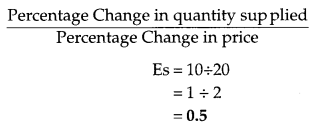
Question 10.
Define utility. Explain the Law of Diminishing Marginal Utility. [4]
Answer:
Utility: Utility is the power or capacity of a commodity to satisfy human want. It is the want satisfying power of a commodity.
purchasing
Section – B
Question 19.
Define Fiscal deficit. [1]
Answer:
Fiscal deficit: It refers to the difference between total expenditure and total receipt of the government budget, apart from its borrowings and liabilities.
Question 21.
An economy is in equilibrium. Find investment expenditure: [3]
National income = 1200
Autonomous consumption expenditure = 150
Marginal Propensity to consume = 0.8
Answer:
Y = \(\overline{\mathrm{C}}\) + MPC (Y) + I
1200 = 150 + (0.8 × 1200) +I
I = 1200 – 150 – 960
= 90
Question 22.
If nominal income is ₹ 500 and price index is 125, calculate real income. [3]
Answer:
Real Income = (Nominal income ÷ Price index of current year) × Price Index of base year.
Let the base year’s price index be 100.
Real Income = (500 ÷ 125) × 100
= 4 × 100
= ₹ 400
Question 24.
Explain the role of Cash Reserve Ratio in controlling credit creation. [4]
Answer:
Cash Reserve Ratio: Commercial banks have to keep a certain percentage of their total deposits with the Central bank in the form of cash reserves. It is very effective in credit. controlling and lending capacity of the banks.
power
Question 27.
Calculate Net National Product at Market Price and (Private income**): [6]
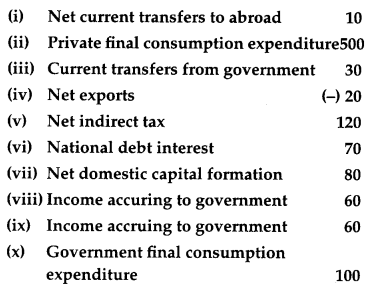
Answer:
GDP
MP
= Private Final Consumption Expenditure + Government Final Consumption Expenditure + (Net Domestic Capital Formation + Depreciation) + Net Exports
= 500 + 100 + (80 + 0) + (-20)
= 600 + 80 – 20
= 680 – 20
= ₹ 660 crores.
NNP
MP
= GDPmp-Depreciation – Net Factor Income to abroad
= 660 – 0 – 20
= 660 – 20
= ₹ 640 crores.
of
the
Section – A
Question 3.
What happens to the difference between Total Cost and Total Variable Cost as output is increased? [1]
Answer:
The difference between Total Cost and Total Variable Cost is total Fixed Cost. Fixed cost remains the same as output is increased. Hence the difference between TC and TVC remains the same as the output increares.
Question 5.
When does ‘shift’ in supply curve take place ? [1]
Answer:
Shift in supply curve takes place when there is change in supply due to change in any of the factors other than the price of the good.
Question 8.
A consumer consumes only two goods X and Y. The marginal utilities of X and of Y is 3. Prices of X and Y are ₹ 2 and ₹ 1 respectively. Is consumer in equilibrium ? What will be further reaction of the consumer ? Give reasons. [3]
Answer:
Marginal utility of X = 3
Price of X = 2
Marginal utility of Y = 3
Price of Y = 1
MUx ÷ Px = 3 ÷ 2 = 1.5
MUy ÷ Py = 3 ÷ 1 = 3
The ratio of Marginal utility to the price of good Y is more than the ratio of marginal utility to the price of good X. Hence, the consumer is not in equilibrium and to reach equilibrium level, the consumer should increase the consumption of Y and decrease the consumption of X.
Question 10.
When price of a good rises from ₹ 8 per unit to ₹ 10 per unit, producer supplies 40 units more. Price elasticity of supply is 2. What is the quantity supplied before the price change? Calculate. [4]
Answer:
Change in quantity supplied (ΔQ) = 40 units
Old price = ₹ 8/ unit
New price = ₹ 10/ unit
Price elasticity of supply is ₹ 2
Quantity = ?
AP = new price – old price
= 10 – 8
= 2/ unit
Es = (ΔQ ÷ ΔP) × (P ÷ Q)
2 = (40 ÷ 2) × ( 8 ÷ Q)
2 = (20) × (8 ÷ Q)
2 = 160 ÷ Q
2Q = 160
Q = 160 ÷ 2
= 80 units
Hence, quantity supplied before price change was 80 units.
Question 11.
Distinguish between individual’s demand and market demand. Name the factors affecting demand for a good by an individual. [4]
Answer:
Individual Demand – Individual Demand for a commodity means the quantity an individual is willing to buy at different prices in a given period of time.
Market Demand – Market Demand means the total demand of all the consumers in the market taken together. It is the sum total of all the individual demands.
Factors affecting demand for a good by an individual:
- Price of a commodity itself (inverse relationship)
-
Price of related goods :
- Substitute goods (direct relationship)
- Complementary goods (Inverse relationship)
-
Income of the consumer
- Normal goods (Direct relationship)
- Inferior goods (inverse relationship)
- Taste and Preference of the consumer (Direct relationship).
Section – B
Question 20.
What are capital receipts in a government budget? [1]
Answer:
Capital Receipts: Government receipts which either create liabilities or reduce assets. Thus, when government raises funds either by incurring a liability or by disposing off its assets, it is called capital receipts .
Question 22.
An economy is in equilibrium. Find investment expenditure: [3]
National Income = 1000
Autonomous Consumption = 100
Marginal Propensity to consume = 0.8
Answer:
National Income (Y) = 1000
Autonomous Consumption (C) = 100
Marginal propensity to consume (c) = 0.8
At Equilibrium, Y = C +1
Y = C + cY +1
1000 = 100 + (0.8 × 1000) + I
1000 = 100 + (800) +I
1000 = 900 + I
1000 – 900 = I
I = 7 100.
Investment expenditure = ₹ 100
Question 23.
If real income is ₹ 400 and price index is 105, calculate nominal income. [3]
Answer:
Real Income = (Nominal income + Price index of current year) × price index of base year.
Let base year’s price index be 100
400 = (nominal income ÷ 105) × 100 Nominal Income
= (400 × 105) ÷ 100
= ₹ 420.
Question 29.
Calculate National Income and (Personal Disposable Income**): [6]

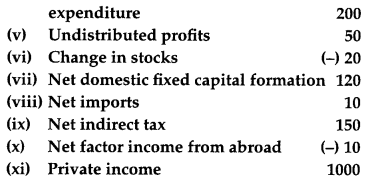
Answer:
GDPmp Private final consumption expenditure + Government final consumption expenditure + (net domestic fixed capital formation + depreciation + change in stock) – net imports
= 900 + 200 + (120 + 0 + (-20) – 10)
= 1100 + (120 – 20) – 10
= 1100 + (100) – 10
= 1200 – 10
= 1190.
NNP
FC
= GDP
MP
+ Net factor income from abroad – net indirect tax – depreciation
= 1190 + (-10) – 150 – 0
= 1190 + (-160)
= 1190 – 160 = 1030
National income = ₹ 1030 crores.